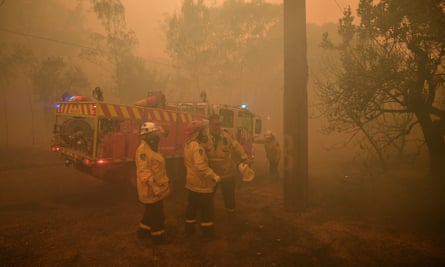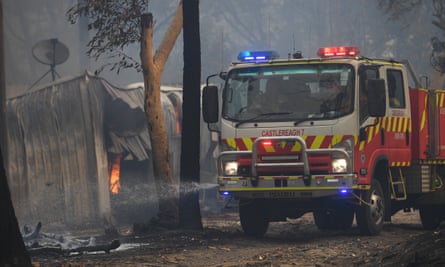Five fires burning to the north of Sydney joined up into one huge conflagration on Friday, with out-of-control blazes threatening homes and lives.
On a day that brought choking smog to Sydney, the premier of New South Wales said the entire coastline of the state was on fire.
Six people have died, and more than 680 homes have already been lost to bushfires in NSW this fire season, and on Friday more than 100 fires were burning, more than half of them out of control. Eight fires have emergency warnings, which means they pose an immediate risk to lives and property.
The largest fire – a conglomeration of five blazes which have joined up north of Sydney – has burned over 335,000 hectares.

The forecast for coming days is for more hot, dry conditions. Strong winds are likely to continue to fan blazes towards towns and properties.
The NSW premier, Gladys Berejiklian, said while fires had been burning across the state for weeks, the sheer scale of the current fire threat was stretching crews’ ability to fight the blazes.
“Previously [the fires] were pretty much confined to the northern part of New South Wales but what we have seen this week is our resources stretched across the entire coastline.

“We have also seen the fires coming in very close proximity to major population centres, whether it is on the south coast, central coast, or even greater western Sydney.”
Berejiklian said homes had been lost, but the full extent of the damage across the state would not be known until after the fires were extinguished, and people were able to return to evacuated areas.
Those forced from their homes might not be able to return for days or weeks.

“We are anticipating conditions worsening next week, especially around Tuesday, and that is why it is important for the community to remain vigilant,” Berejiklian said.
At Kulnara, 85km north of Sydney, dozens of firefighters and trucks stood ready on Friday afternoon ahead of a predicted wind change. But unpredictability was hindering firefighters’ efforts to tackle blazes.
Earlier in the day wind changes had pushed a fire past some properties, only to swing the blaze back towards homes another way.
Shane Hilson’s property is situated north of the town. “It came in over the back, then it went right up along the ridge, and then it came back all the way down the back and around,” he said, pointing to a line of trees on the edge of one of his paddocks”.
“There’s nothing left to burn,” he said.
Hilson’s wife and children went to her mother’s place two days ago, while his father-in-law came to help him fight the blaze.
Both men were bleary eyed and exhausted, but had nothing but praise for the Rural Fire Service.

“These fellas have been marvellous, hey,” Hilson said.
Hilson’s neighbour, Rob Meggs, described how the fire destroyed his shed, office and one of the fire vehicles.
The shed was “a hoarder’s heaven”, he said.
“It was full of stuff [and] that might be a release in one way. But my office, that might be a bit more painful. It had some records in there that I won’t be able to replace.”
The house at this Kulnura property was saved from the Wrights Creek fire but they lost their shed and office space. pic.twitter.com/cDbB9Btw9O
— Helen Davidson (@heldavidson) December 6, 2019
Meggs’s house survived, thanks to the efforts of the RFS and metropolitan firefighters.
He was cautious not to get too close to the still-burning ruins; he thought all the petrol cans had exploded but there were still paint cans under the collapsed structure.
He stayed to defend the house: “We were advised earlier in the week at a meeting that the conditions weren’t catastrophic and if you were physically able and prepared [you could stay].”
He’s been in his house 22 years, and hasn’t seen anything so big.
The NSW Rural Fire Service commissioner, Shane Fitzsimmons, said a long-term forecast of low rainfall and above-average temperatures meant some fires could burn for weeks, even months.
“We’ve still got months ahead of challenge and the only forecast for rain is late January to early February of any meaningful substance.”

Sydney has been choked by thick smoke for almost a week.
Hospital emergency departments have seen a 25% increase in people presenting with asthma and breathing problems, and ambulance crews are responding to between 70 and 100 call-outs a day for respiratory conditions, including to school children as young as six.
Some schools across the state have been closed because of the fire risk, while others have kept children inside because of the worsening air quality.
The moon from Sydney airport has taken a red appearance from the smoke off the QLD fires. #spooky pic.twitter.com/09PpzAKXbK
— Ciarán Gearoid (@CiaranGearoid) December 6, 2019
Surf Life Saving NSW has told all club life saving captains to close beaches if the air quality is too poor.
Twenty-one firefighters from Canada have flown in to assist crews across NSW. A contingent from the US is due to join the frontline on Sunday.